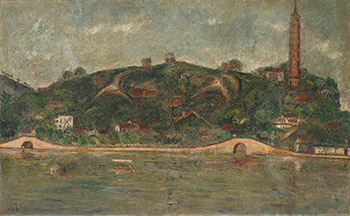ILLUSTRATED:
Taiwan Fine Arts Series I: Chen Cheng Po, Artist Publishing Co.Ltd., Taipei, 1992, black and white illustrated, p. 211
Journey Throogh Jiangnan–A Pivotal Moment in Chen ChengPo’s artistic Quest, Taipei Fine Arts Museum., Taipei, 2012, blackand white illustrated, p. 36
Catalogue Note:
Scenery of the West Lake
Baoshi Mountain
Chen Cheng-po has a unique prominence in history. A first generation Western style painter born in Taiwan, his talent and spirit of independent thinking allowed him to integrate Chinese and Western aesthetics and focus on the essence of form. His style is modest yet weighty, bearing passionate energy. He not only walked a unique path in contemporary art history with a life tied closely to Taiwan, Japan, and China; his struggle, ideals, passion, and aesthetics made him a legend in 20th century Asian history. Painted in 1928 on Chen Cheng-po’s first visit to the West Lake, “Scenery of the West Lake: Baoshi Mountain” represents a meaningful chapter in the artist’s life.
Born in February of 1895, Chen Cheng-po was only an infant when China ceded Taiwan to Japan after a loss in the Sino-Japanese War in May of the same year. For the fifty years that followed, Taiwan was under Japanese colonization. Growing up in Taiwan under Japanese settlement, Chen Cheng-po deeply understood that as a second-class citizen under the colonial government, rather than giving in to fate, what he needed to do was to strive to realize his dreams, and earn respect through his abilities. He had had grand dreams of art since he was young, wanting to study in Japan since he attended elementary school. But due to his family’s financial situation, he chose to become a teacher after graduating in 1917. Seven years later, at almost 30 years old, Chen Cheng-po finally left for Japan, and was accepted into the Painting Department of the Tokyo School of Fine Arts. Also studying in Tokyo at the time was Lin Yu-shan, who once wrote in the article “Memories of Befriending Mr. Chen Cheng-po”, “Mr. Chen studies at the art school by day, and by night he goes to the Hongo Art Institute to practice his sketches, studying tirelessly regardless of whether it’s rain or shine. …on Sundays and holidays, he never participates in unnecessary entertainment, always off painting in the countryside with his painting supplies.” (“Lionart”, 1979. 12, pg. 20) Though Chen Cheng-po didn’t have the chance to learn many oil techniques in Taiwan, his strong sense of honor and tireless effort made him improve rapidly in the span of a few short years in Tokyo, and his self-awareness led to the development of a unique personal style. In 1926, his third year in Japan, Chen Cheng-po’s work “Outside Chiayi Street” was selected for the Imperial Art Exhibition, the most prestigious in Japan, making him the first Taiwanese painter to have an oil painting accepted for the exhibition. He continued to study in the graduate program after graduating from the Tokyo School of Fine Arts. His art is widely appreciated, and he befriended Chinese artists such as Wang Jiyuan.
In 1928, Chen Cheng-po set foot in mainland China. He visited Hangzhou West Lake and Shanghai, personally experiencing the southern Chinese scenery that has inspired countless poets and artists for generations. The visit inspired great ambitions, and he created many paintings. Local artists he befriended held a “Chen Cheng-po West Lake Memorial Exhibition” for him to welcome this talented young artist. “Scenery of the West Lake: Baoshi Mountain” is one of the grand pieces completed during this journey. The artist uses horizontal composition to narrate the famous scenery of West Lake. In the painting, Baoshi Mountain rises gently, surrounding jade green waters. On the mountain are lush woods and winding paths, among which houses with white walls and red tiled roofs peek through. The elements work together to create a colorful, harmonious, and lighthearted scene. Towering on the right is Baochu Pagoda, a famous sight near West Lake, leading our gaze to the bright clear sky, where white clouds float leisurely. And on West Lake, the green mountain and houses are reflected in the clear, shimmering surface. The Su Causeway lays between mountain and water; its simple silhouette sets off the clear, shimmering waters, creating an elegant and moving scene. A small boat travels on the surface of the lake, taking in the grand lake scenery with its mountains and waters, to the viewer’s envy.
A year after painting this piece, Chen Cheng-po graduated from the Graduate Department of the Tokyo University of Fine Arts, and was appointed head of the Western Painting Department at Shanghai’s Xinhua Art College, bringing new artistic concepts and inspiration to young artists along with fellow artists Chen Baoyi and Wang Yachen. In Chen Cheng-po’s artistic career, “Scenery of the West Lake: Baoshi Mountain” has an important place in history, representing both the artist’s accomplishment after studying in Japan, as well as his patriotism. In 1947, Chen Cheng-po’s life came to an abrupt end amidst turbulent times. “Scenery of the West Lake: Baoshi Mountain” also once disappeared, yet now has resurfaced for the first time in decades — a truly precious piece.
